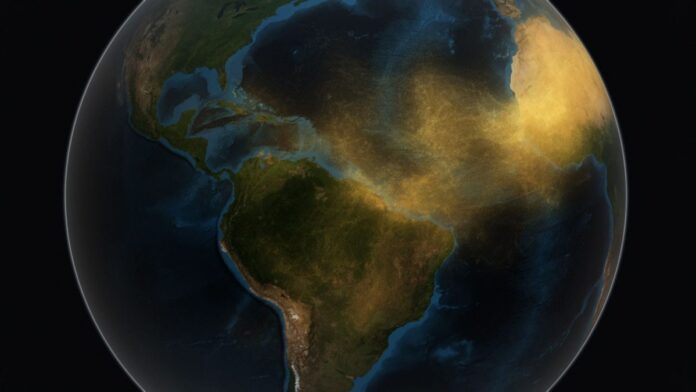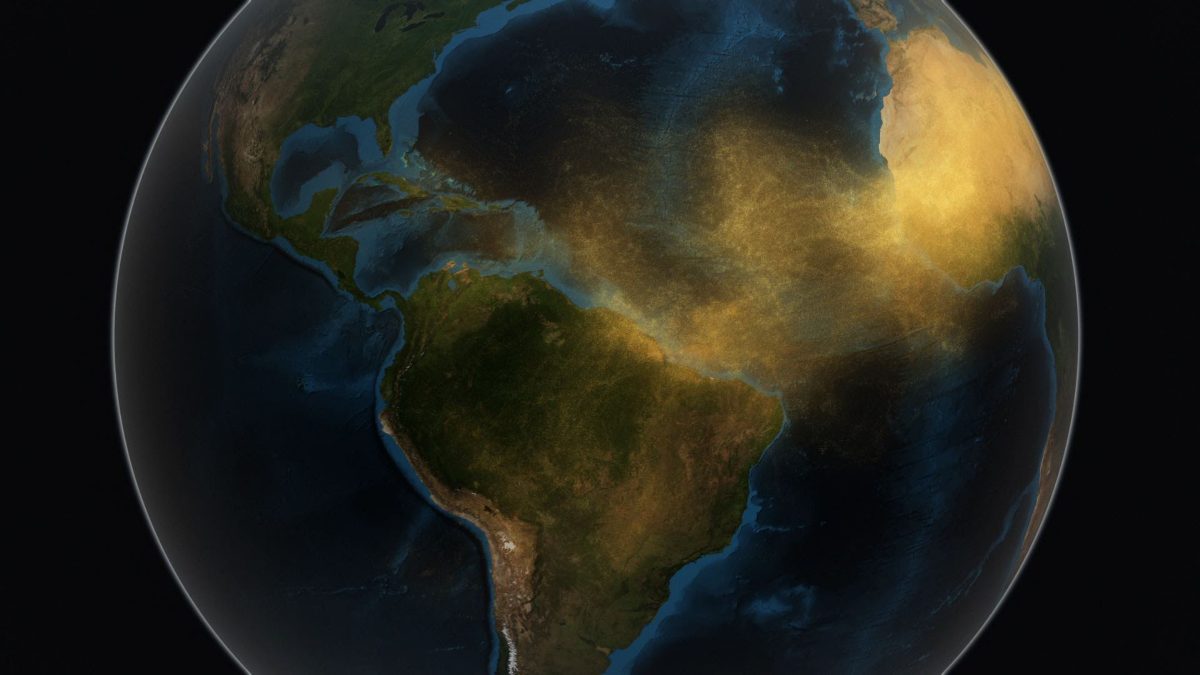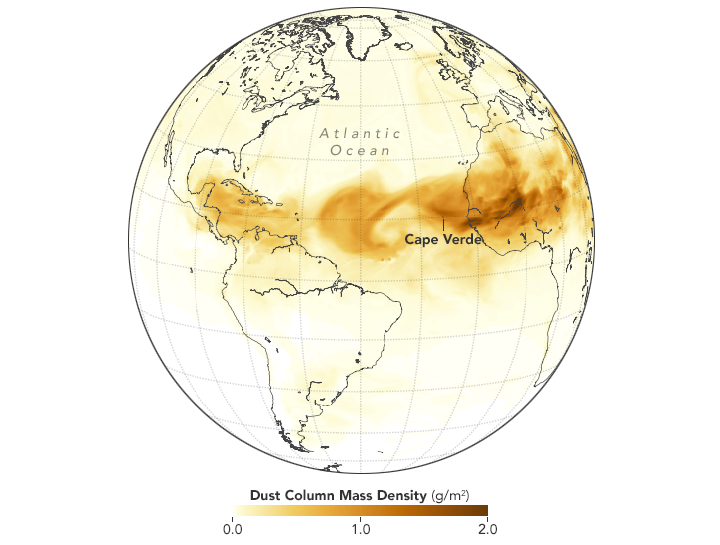By RICK KELLEY
HARLINGEN — This dust thing is starting to grate.
The Texas coast and the Rio Grande Valley are going to continue to take a breezy battering coming at us from 7,000 miles away.
Unusual atmospheric conditions known as Saharan dust plumes have been flowing across the Atlantic and Caribbean, and are wafting into South Texas and to a lesser degree over most of the rest of the state, too.
The first one arrived in Texas on June 29, and others have followed. National Weather Service forecasters in Brownsville say another plume should arrive this weekend, creating hazy, brown-sky conditions and triggering allergy and asthma problems in people who are susceptible to airborne particulates.
In fact, conditions are such that these African dust bands could be with us for at least the next two weeks.
“It’s pretty much the same pattern that we’ve seen the last three weeks,” said Jason Straub, a meteorologist with the National Weather Service in Brownsville. “We’ve got a large area of high pressure over the Atlantic Ocean and it’s just deflecting all this Saharan dust across the southern Atlantic and it’s moving across the Caribbean and the southern gulf into South Texas.”
The plumes originate in the great Sahara desert of North Africa. The bands of dust currently besieging South Texas are not necessarily uncommon, but it is relatively rare for them to arrive here in such dense plumes.
“Another fairly intense pulse of African dust is expected to arrive in South and Southeast Texas along the coast before pushing inland into parts of Central and Southeast Texas, with at least light amounts lingering in patches across the remainder of the state,” the Texas Commission on Environmental Quality reported Thursday in its air-quality forecast.
Airborne particle pollution will be “moderate” in the Valley at least through Sunday, TCEQ said.
Dr. William McKenna is an allergy and asthma specialist in Harlingen. Not surprisingly, he says some people here in the Valley are suffering symptoms linked to the dust.
“It’s kind of the equivalent, if you will, to a poor-quality air day,” he said. “You can visibly see it being hazy if you’re looking into the air, particularly on a bad day. What that means is you have a lot of particles in the air, and for anybody who has respiratory symptoms or eye problems, they’re going to have a likelihood of increased symptoms.
“And yes, we have seen that with a lot of our patients,” he added.
Atmospheric pressure
Dust storms blowing out of the Sahara desert are not uncommon. What has changed this year is a set of unique atmospheric conditions has plopped down a high pressure system in the middle of the Atlantic Ocean.
These dust plumes can’t be picked up on weather radar, but they do show up strongly on weather satellites. In this case, it’s the GOES-16.
“It can see the differences in density and things like that, so it picks it up and we can tell when the plumes are coming in, when they’re going to start to fade and whether there are any more lined up in the Atlantic waiting to come through,” Straub said.
Satellite imagery shows the high in the Atlantic directing the Saharan dust around its southern edge, creating a river of particles which are swinging below it and streaming straight through the Caribbean Sea into the Gulf of Mexico and then into Texas.
“I happened to notice that six years ago the high was further north so all the Saharan dust deflected into Florida,” said Straub. “They had all the Sahara dust. Sometimes the high pressure is well to the south though and it doesn’t even get out of the Sahara and it just moves straight north across the northern Atlantic. It all depends on where that high is.”
McKenna’s theory is that the dust is so noticeable this summer in South Texas because of how the high pressure is shaping its movement and funneling it westward.
“The other thing that’s kind of interesting along that line, and I think this is more of a meteorologist-type statement, but from what I understand typically the area of distribution of the dust is more of a wider area than it is right now,” he said.
“Because of the high-pressure system, it’s kind of condensed it more into the Caribbean and the gulf area … that would seem to mean that if you have a narrower band of it because of the high pushing it and kind of compressing it into this area only, it may be more of a dense type of an exposure.”
The good news
In the Valley in summer, most people keep an eye open for a lot more than dust.
The hurricane season so far has been quiet, unlike last year.
Some experts think the African dust storms over the Atlantic could be beneficial in tamping down, or at least delaying, the onset of peak hurricane season.
“The main research that’s been done on it is that with all the extra dust in the atmosphere, it’s reflecting a little sunlight back out into space, so it’s not heating the surface waters of the Atlantic as fast as normal for the tropical season,” Straub said. “So water temperatures out in the Atlantic are cooler than they usually are, so that’s going to suppress at least the beginning of the tropical season.”
Treatment options
Like McKenna’s patients, Straub said his own family has been affected by the Saharan dust plumes.
“I can tell you that even my son is allergic to it as well,” he said. “He’s 4 years old, so the first day it started to come in, we noticed he started sniffling a little bit and he’s been coughing ever since. So we notice when it comes in, it affects him.”
McKenna said staying inside — which he wryly notes is not hard to accomplish in the middle of a Valley summer — is perhaps the best way to avoid respiratory problems from the dust.
“Avoidance is always number one, if they can do that to some degree,” he said. “Number two is basically treating the symptoms with more medications. If they have, for example, conditions like asthma, they may need to use their immediate or fast-acting inhaler more frequently.”
Sinus problems, he said, can be dealt with using nasal spray or antihistamines.
But he said the dust particles can cause problems for anybody with respiratory issues.
“It’s not exclusively with patients who have, say, allergies or asthma,” McKenna added. “It’s across the board with any respiratory condition. For example, clearly a non-allergic condition like COPD (chronic obstructive pulmonary disease) is worse, too. The impure air can activate their symptoms. Patients who have chronic sinusitis that is not related to allergies necessarily, certainly they can get much worse, too.”






